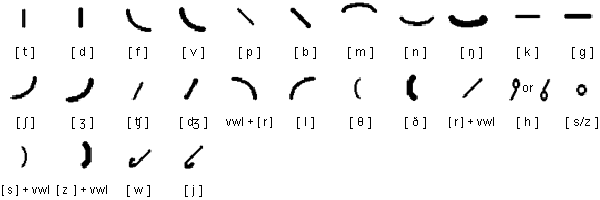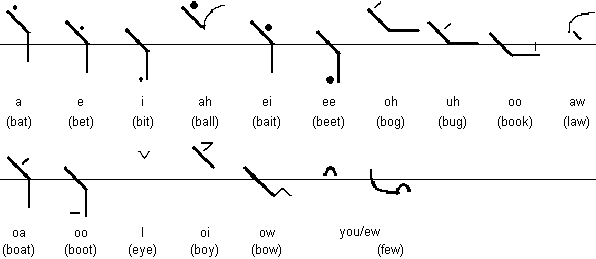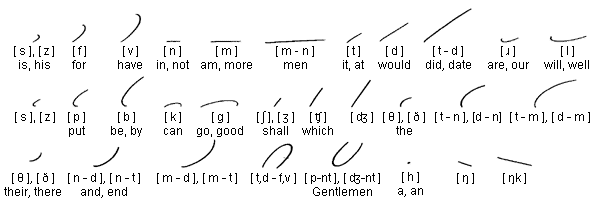Shorthand is any system of rapid handwriting which can be used to transcribe the spoken word. Shorthand systems use a variety of techniques including simplifying existing letters or characters and using special symbols to represent phonemes, words and phrases.
Ever since the invention of writing scribes have used various techniques to enable them to take notes quickly and efficiently.
The Ancient Egyptians devised two scripts, Hieratic and Demotic, as alternatives to their complex Hieroglyphic script, which was used mainly for monumental inscriptions. Both Hieratic and Demotic worked on the same principles as the Hieroglyphs but the symbols were considerably simplified.
During the 4th century BC, the Greeks devised a number of symbol systems which reduced letters to a single stroke and which could also be used to represent common words, suffixes and prefixes. Such systems are generally referred to as stenography (narrow writing), brachygraphy (short writing) or tachygraphy (swift writing). Their purpose was to make writing more compact and/or faster.
One shorthand system popular with the Romans was Tironian Notes or Notae Tironianae, which was invented by Cicero's secretary Tiro in order to record Cicero's speeches. It used a combination of simplified letters and special symbols and was used in Europe in various forms until the Middle Ages.
During the Han Dynasty (207BC - 220AD) the Chinese devised two methods of rapid writing known as xíngshū (running script) and căoshū (draft script). In the Running script some of the strokes that make up characters are joined and others are left out. In the Draft script each character is written with a single continuous stroke and there is considerable variation in how this is done. As a result, the Draft script is very difficult to read without special training. Attempts have been made to standardise the way the characters are written in the Draft script but they have not met with popular acclaim.
There are a number of different shorthand systems currently in use. The most popular ones include:
Pitman Shorthand was devised by Sir Isaac Pitman (1813-1897) and was first published in 1837. Over the years is has been gradually improved and has been also adapted for 15 different languages. The system was widely used in the UK and USA by secretaries, reporters and writers, but lost popularity with the invention of pocket tape recorders.




All human beings are born free and equal in dignity and rights. They
are endowed with reason and conscience and should act towards one another
in a spirit of brotherhood.
(Article 1 of the Universal Declaration of Human Rights)
Gregg was invented by John Robert Gregg (1867-1948) and was first published in 1888. Since then many different versions have appeared, including some for languages other than English. Gregg is still used, particularly in the USA.




All human beings are born free and equal in dignity and rights. They
are endowed with reason and conscience and should act towards one another
in a spirit of brotherhood.
(Article 1 of the Universal Declaration of Human Rights)
Gregg illustrations provided by Andrew Owen.
Information about Shorthand | Tower of Babel in Pitman Shorthand | Tower of Babel in Gregg Shorthand | Books about Shorthand
Informationa about Shorthand
http://en.wikipedia.org/wiki/Shorthand
http://www.alysion.org/handy/althandwriting.htm
http://shorthandshorthandshorthand.com
Pitman Shorthand
http://en.wikipedia.org/wiki/Pitman_shorthand
http://pitmanshorthand.homestead.com
http://www.long-live-pitmans-shorthand.org.uk
http://long-live-pitmans-shorthand.blogspot.co.uk
Gregg Shorthand
https://en.wikipedia.org/wiki/Gregg_shorthand
https://greggshorthand.github.io/
Teeline shorthand
https://en.wikipedia.org/wiki/Teeline_Shorthand
http://www.offbeatband.com/2010/12/teeline-shorthand-for-students-the-workplace-and-the-lazy/
https://www.letsloveteelinetogether.com/
Groote shorthand - a Dutch shorthand system designed for take notes while on horseback
http://www.waij.com/shorthand/
Deutschen Einheitskurzschrift (German Unified Shorthand)
http://de.wikipedia.org/wiki/Deutsche_Einheitskurzschrift
Shorthand converter
http://steno.tu-clausthal.de/DEK.php
Alchemical symbols, Blissymbolics, Graffiti, Shorthand, Solresol, Sutton SignWriting, Yi Jing Hexagrams
Page last modified: 10.10.23
[top]
You can support this site by Buying Me A Coffee, and if you like what you see on this page, you can use the buttons below to share it with people you know.

If you like this site and find it useful, you can support it by making a donation via PayPal or Patreon, or by contributing in other ways. Omniglot is how I make my living.
Note: all links on this site to Amazon.com, Amazon.co.uk
and Amazon.fr
are affiliate links. This means I earn a commission if you click on any of them and buy something. So by clicking on these links you can help to support this site.
[top]